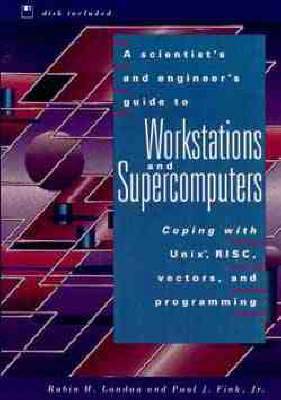
A Scientist's and Engineer's Guide to Workstations and Supercomputers
John Wiley & Sons Inc (Verlag)
978-0-471-53271-2 (ISBN)
- Titel ist leider vergriffen;
keine Neuauflage - Artikel merken
A scientist's and engineer's guide to Workstations and Supercomputers Crack the Unix code and put its power to work for you. If you're seeking such clear-cut guidance, your search will end with the first Unix survival manual designed specifically for practicing scientists and engineers like you. Avoiding the narrower concerns and complicated jargon of computer science, this guide shows you how to master the complexities of accomplishing computer projects - from start to finish - predominantly under a Unix operating system. With the help of clarifying examples and tutorials, you'll learn how to write and organize files and programs as well as run, debug, and visualize the results of scientific programs on workstations and supercomputers. At the same time, you'll discover how to complete these projects while working on other systems and on other versions of Unix. This user-friendly guide offers you the basics on Unix commands and on setting up and using workstations, and goes on to simplify the once-daunting tasks of transferring files between workstations and adjusting X Windows.
You'll also gain a solid grasp of more advanced Unix tools, such as its sophisticated editing, filing, and debugging capabilities, and of programming computers with differing architectures. Complete with accompanying computer disk packed with practice programs and data files, this book will increase your creativity, productivity, and effectiveness on the job by demonstrating how you can quickly learn to wield one of your most formidable tools - the Unix system. Covers all major versions of Unix and systems from major hardware vendors, including: System V, BSD, IBM's AIX, SUNOS, HP-UX, Unicos.
RUBIN H. LANDAU is a Professor of Physics at Oregon State University in Corvallis. He has been using computers in his theoretical nuclear and particle physics research for the past 25 years. The author of more than 50 refereed publications, he is the author of Quantum Mechanics II: A Second Course in Quantum Theory (Wiley, 1990). PAUL J. FINK, JR. has developed and supported different Unix systems at the University of Minnesota, Oregon State University, and at IBM's T. J. Watson Research Center. A staff member at Thinking Machines Corporation in Cambridge, Massachusetts, and a former student with Professor Landau, he helped develop the new RS/6000 workstation.
PART I: GETTING STARTED: Getting Friendly with Unix; Workstation Setup and Use; Computer-Computer Interactions; Looking Through X-Windows; PART II: TOOLS: Introduction to Graphics and Visualization; Scientific Graphical Tools; Using Fortran and C with Unix; Different Compilers and Their Options; Unix Tools and Tips; PART III: TECHNIQUES FOR POWER USERS; Scientific Programming Hints; RISC and Computer Architectures; Programming for RISC and Vector; Parallel Computing; Future of Scientific Computing; Appendices; References.
| Erscheint lt. Verlag | 26.1.1993 |
|---|---|
| Zusatzinfo | Illustrations |
| Verlagsort | New York |
| Sprache | englisch |
| Maße | 177 x 252 mm |
| Gewicht | 765 g |
| Themenwelt | Informatik ► Betriebssysteme / Server ► Unix / Linux |
| Informatik ► Weitere Themen ► Hardware | |
| Naturwissenschaften | |
| Technik | |
| ISBN-10 | 0-471-53271-1 / 0471532711 |
| ISBN-13 | 978-0-471-53271-2 / 9780471532712 |
| Zustand | Neuware |
| Haben Sie eine Frage zum Produkt? |
aus dem Bereich


